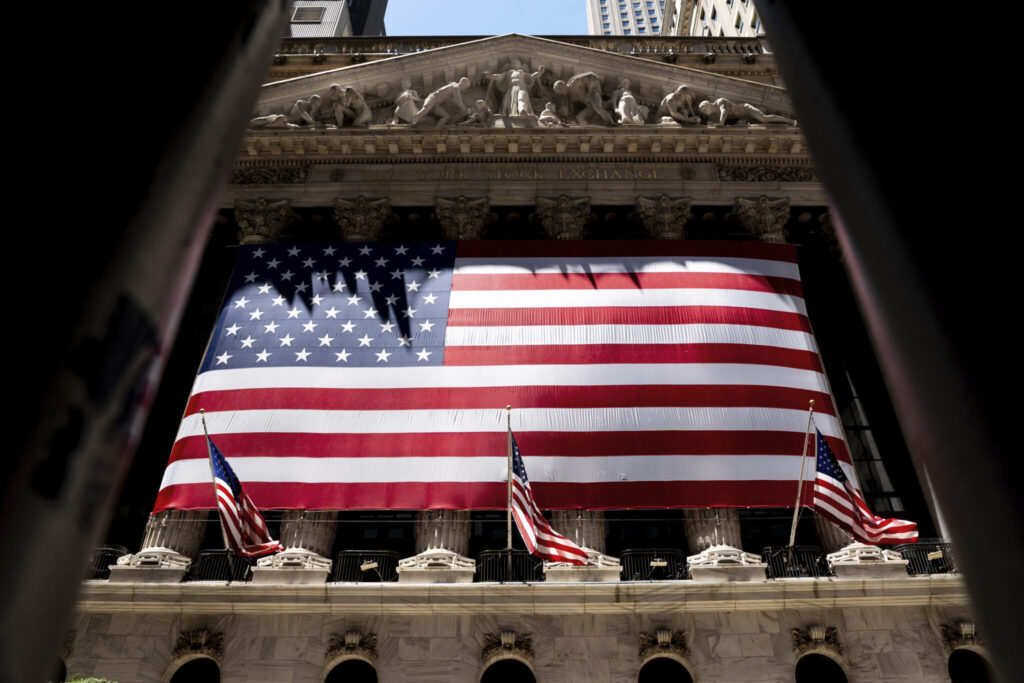The S&P 500 ended lower and the Nasdaq higher on Thursday after U.S. inflation data matched estimates, underscoring expectations the Federal Reserve could pause its monetary tightening, while Salesforce climbed following an up upbeat forecast. The Nasdaq reached its highest in over four weeks after a Commerce Department report showed the Personal Consumption Expenditures (PCE) price index, considered the central bank’s preferred inflation gauge, climbed 3.3% in July on an annual basis, in line with expectations. The Associated Press has the story:
Wall Street ends lower, closes 1st losing month since Feb.
Newslooks- NEW YORK (AP)
A late-afternoon fade left stocks modestly lower Thursday as Wall Street closed out its first losing month since February.
The S&P 500 gave up an early gain to close 0.2% lower. The benchmark index ended August down 1.8%, though a four-day winning streak going back to last week helped chip away at the severity of the monthly decline.
The Dow Jones Industrial Average fell 0.5%, while the Nasdaq composite eked out a 0.1% gain.
Market jitters over the possibility that the Federal Reserve might have to keep interest rates higher for longer following reports showing the U.S. economy remains remarkably resilient led to the market’s pullback in August after what had been a banner year. This week, reports on job openings, consumer confidence and inflation stoked hopes on Wall Street that the Fed may hold rates steady at its next policy meeting in September.
That helped limit the market’s losses for August. The S&P 500, which soared 19.5% through July, remains 17.4% higher for the year, while the tech-heavy Nasdaq is up 34.1%. The Dow is up 4.8%.
“We’ve kind of entered this point of the year where economic data and earnings are mostly set, in terms of the market’s expectations,” said Michael Antonelli, market strategist at Baird. “But if we get cooler jobs data, cooler inflation data, if we get cooler spending data, that’s what brings rates down dramatically and that gooses stocks higher. That’s kind of what we saw this week.”
On Thursday, the government reported that a measure of inflation closely tracked by the Federal Reserve remained low in July. The latest update for personal consumption and expenditures, or the PCE report, is the latest sign that price increases are cooling.
The central bank has raised its main interest rate aggressively since 2022 to the highest level since 2001. The goal has been to rein inflation back to the Fed’s target of 2%. PCE measured 3.3% in July, matching economists expectations. That’s down from 7% a year ago.
The latest inflation data follows updates on jobs and consumer confidence this week that also supports hopes for the Fed to pause interest rate hikes. The central bank held rates steady at its last meeting and is expected to do the same in September. Investors are expecting rates to hold steady for the remainder of 2023, according to CME’s FedWatch tool.
The Fed has maintained that it is ready to keep raising interest rates if it has to, but will base its next moves on the latest economic data.
“The last hike they made potentially could be the last for the year,” said Chris Zaccarelli, chief investment officer for Independent Advisor Alliance. “As long as inflation remains controlled and contained, I think the Fed is done raising interest rates.”
Bond yields fell again Thursday. The yield on the 10-year Treasury slipped to 4.10% from 4.11% late Wednesday. The yield on the 2-year Treasury, which tracks expectations for the Fed, edged lower to 4.85% from 4.88% late Wednesday.
Wall Street has one more big economic update to look forward to this week. On Friday, the government will report employment data for August. The strong job market, along with consumer spending, has so far helped thwart a recession that analysts expected at some point in 2023. But, they also made the Fed’s task of taming inflation more difficult by fueling wage and price increases.
The Fed is hoping that it can accomplish taming interest rates without sending the economy into a recession. The likelihood of a recession, or at least a severe one, has seemingly been fading and in turn fueling confidence in the market in 2023, despite the recent August slump.
“Sooner or later you need to have a pullback,” Zaccarelli said. “The market can’t go up in a straight line all the time.”
Health care stocks and banks were among the biggest drags on the market. UnitedHealth Group fell 3%, while Elevance Health fell 3.8%.
Gains in technology stocks helped stem the S&P 500’s slide. Broadcom rose 3.4% and Intel rose 1.8%.
Software company Salesforce rose 3% after raising its profit forecast for the year. Cloud-based security company CrowdStrike jumped 9.3% after reporting strong financial results.
Dollar General was among several retailers slipping after reporting weak earnings and forecasts. It slumped 12.2% after cutting its profit forecast for the year.
All told, the S&P 500 fell 7.21 points to 4,507.66 Thursday. The Dow lost 168.33 points to 34,721.91, and the Nasdaq rose 15.66 points to 14,034.97.
Markets in Europe mostly fell. Annual inflation there held steady in August as food prices raced ahead of falling fuel costs, but there was no clarity about whether the European Central Bank will pause its record series of interest rate hikes.
Asian markets were mixed.







